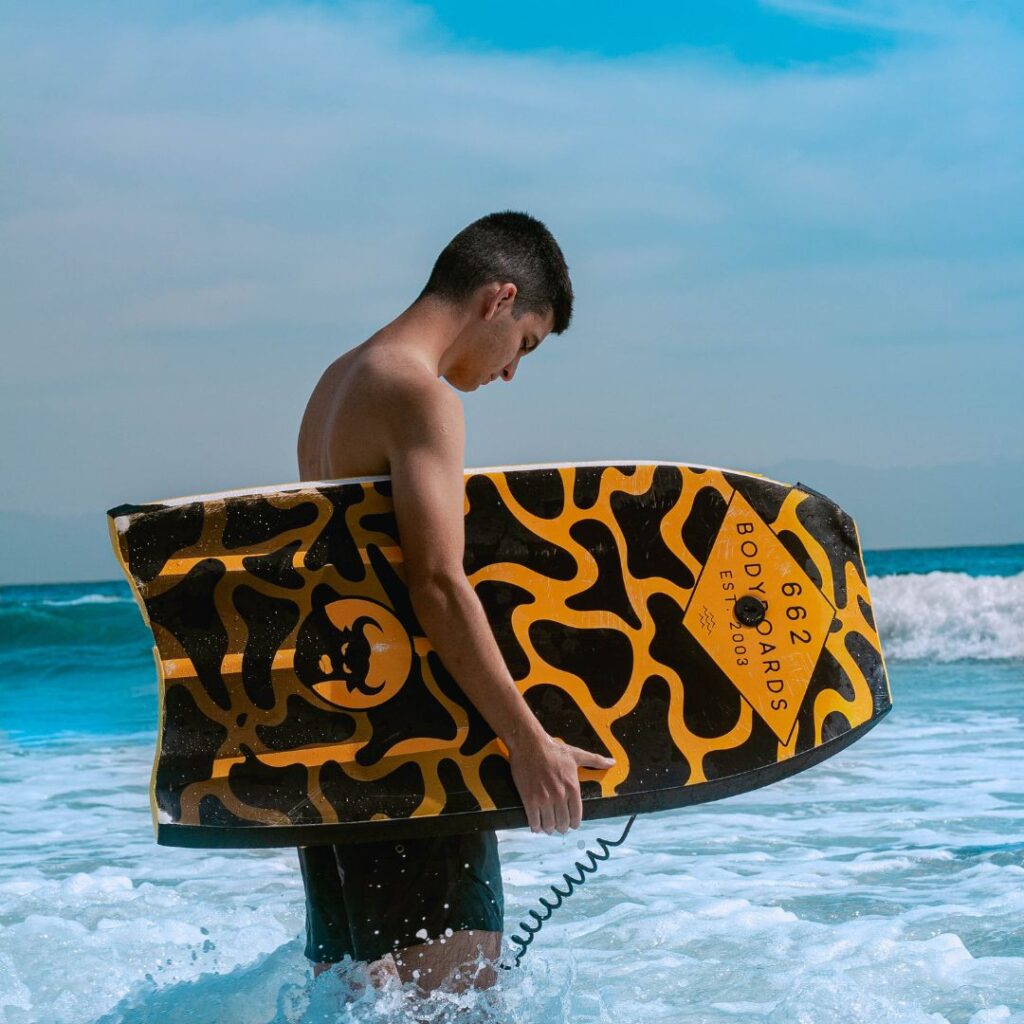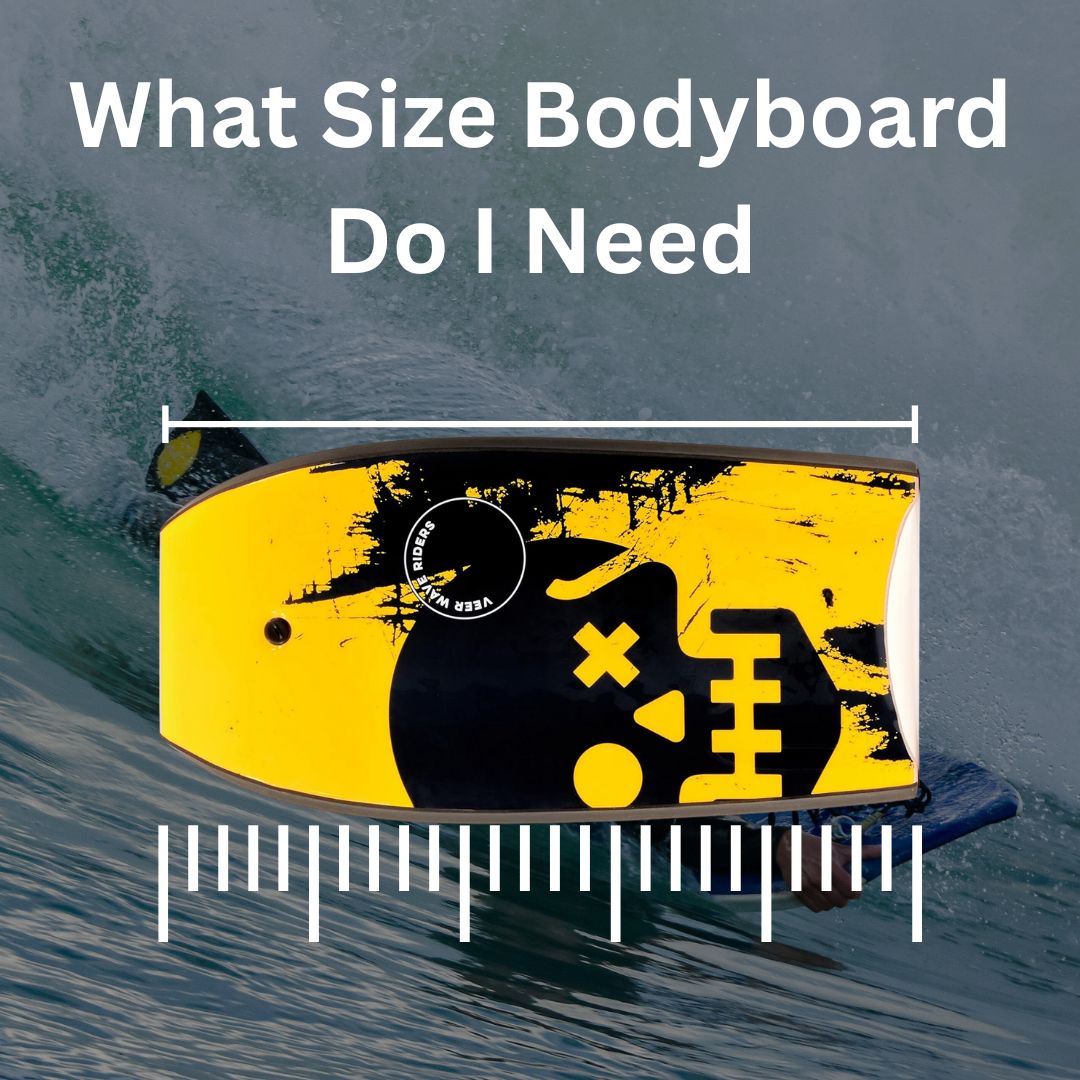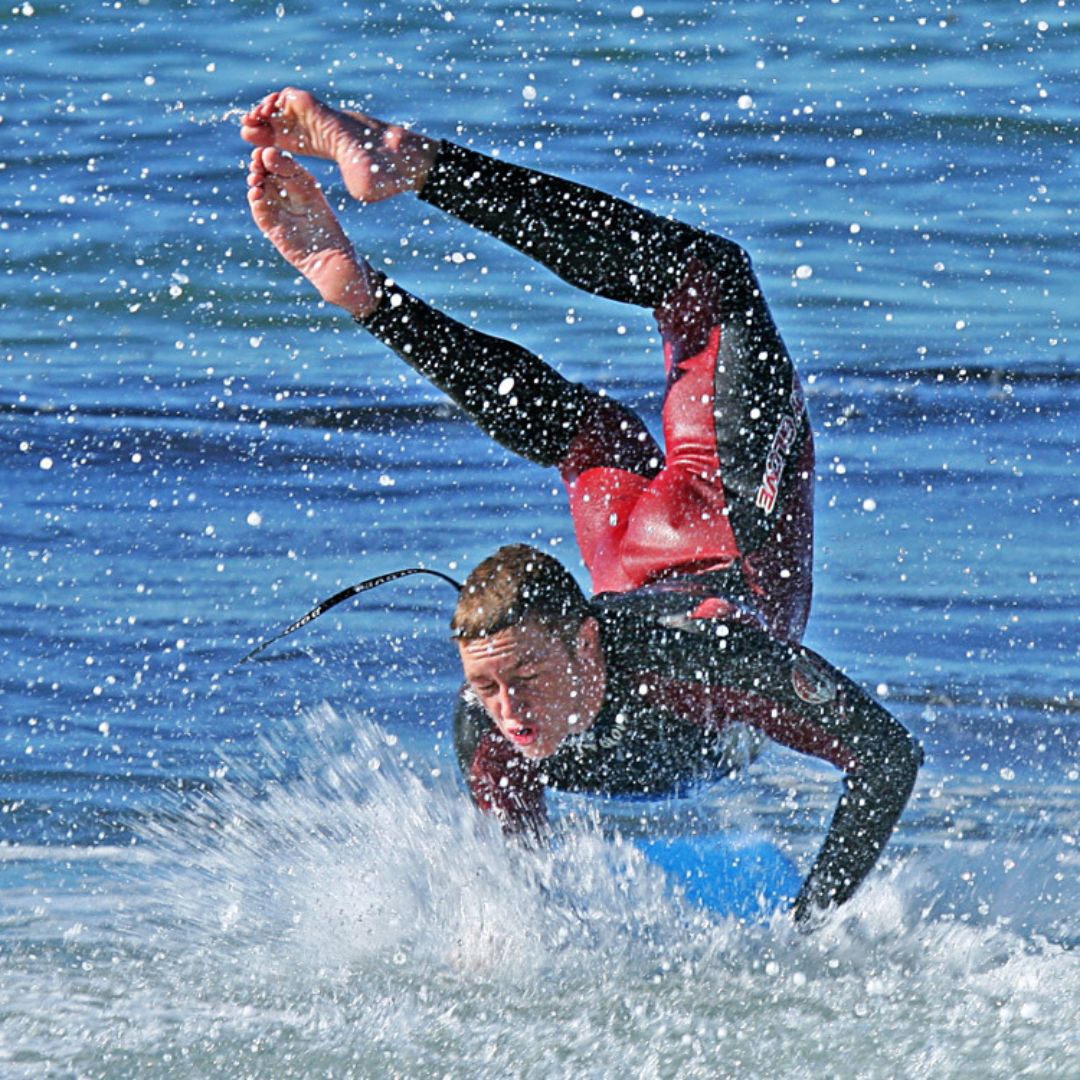How To Bodyboard – from A Beginner to A Pro
How to bodyboard might sound like a simple question – just toss yourself on a floating foam plank and hope for the best, right? That’s the ocean’s version of winging it. Which, by the way, works out about as well as riding a unicycle in a thunderstorm.
Most beginners think they’ll look like Kelly Slater in five minutes, but end up collecting more sand in their wetsuit than a crab in a beach volleyball match.
But here’s the truth: learning how to bodyboard is one of the fastest, most fun ways to ride waves, even if you’ve never surfed a day in your life. It’s accessible, beginner-friendly, affordable, and doesn’t require the balancing act of surfing. Still, there are a few skills, techniques, and critical safety tips you’ll want under your belt before you charge into the whitewash like Poseidon’s understudy.
How to Bodyboard?
To bodyboard properly, follow these five fundamental steps:
1. Choose the Right Bodyboard
Size and type matter. If it’s too small, you’ll sink or nosedive. Too big, and you can’t maneuver. (More on what size bodyboard do I need below.)
2. Head to a Beginner-Friendly Beach
Start in mellow, rolling surf. Stay away from shore breaks or reefs until you’ve got some experience.
3. Paddle Out Safely
Use your fins to kick past the whitewash. Paddle using both arms and flutter kicks. Learn to duck dive under oncoming waves.
4. Catch the Wave
Spot a wave approaching behind you, start kicking with your fins, and paddle forward. As the wave lifts you, arch your chest slightly, grip the rails, and boom—you’re riding.
5. Ride and Steer
Shift your weight subtly to turn, trim, or ride down the line. Avoid stiff arms or locking your body. Fluidity is key.
That’s how to bodyboard in a nutshell, but if you want to ride like a pro or at least not faceplant in front of 10-year-olds with GoPros, keep reading.
How to Bodyboard for Beginners
If you’re new to the sport and wondering how to bodyboard for beginners, think of it as ocean sledding with a splash of strategy. Here’s a simple step-by-step to get you started:
- Get the Right Gear: Choose a bodyboard that fits your height (up to your belly button when standing). Fins are a huge help, especially for catching waves early.
- Pick the Right Beach: Start at a sandy beach with small, rolling waves. Avoid rocky areas or powerful shore breaks.
- Lie on the Board Properly: Your hips should rest at the back of the board. Grip the sides (rails) with your elbows bent and chest slightly lifted. Eyes on the wave, not your toes!
- Paddle and Kick: Use a flutter kick with your fins and paddle with your arms. You’ll need to catch momentum as the wave lifts your board.
- Ride the Wave: Once the wave picks you up, keep your weight balanced. Shift slightly left or right to steer.
- Have Fun (and Be Okay with Wipeouts): You will fall off. That’s part of the fun. Smile, reset, and paddle out again.
It’s a learning curve, but once you catch your first real ride, you’ll understand why people become lifelong fans of bodyboarding.
Bodyboarding vs. Boogie Boarding: What’s the Difference?
So, bodyboarding vs boogie boarding – are they different sports or just two names for the same thing?
Technically, they’re the same activity: riding waves on your belly using a foam board. The difference comes down to terminology and perception:
- Boogie Board: This term comes from the original 1971 invention by Tom Morey, who called it the “Boogie Board.” Today, it’s often used casually to describe cheaper, mass-market boards – think kids at the beach or vacation rentals.
- Bodyboard: This is the term used by more serious riders and manufacturers. Bodyboarding suggests higher-quality boards, performance fins, and riders who pursue more advanced maneuvers (like spins, barrels, and drop-knee stances).
In short: All boogie boards are bodyboards, but not all bodyboards are just “boogie boards.” If you’re taking the sport seriously, use “bodyboarding.”
How to Bodyboard for Kids
If you’re introducing little ones to wave riding, here’s how to bodyboard for kids safely and enjoyably:
- Use the Right-Sized Board: Get a kids’ bodyboard that’s lightweight and matches their height. Many come with soft foam and a wrist leash for safety.
- Stay in the Shore Break: Don’t toss them into big surf. Keep them in shallow water where waves are gentle. They can ride broken waves (whitewater) safely.
- Stay Close and Supervise: Always stay within arm’s reach. The ocean can be unpredictable, even in shallow water.
- Teach Them the Basics: Show them how to lie on the board, hold the sides, and kick with their feet. Keep instructions simple and playful.
- Make It Fun, Not Formal: Let them play. Don’t push technique too hard at first. Building confidence and positive ocean experiences is what really matters.
Pro tip: Wetsuits keep them warm and protected from scrapes, and always use sunscreen – yes, even on cloudy days.
READ ALSO: Can You Use Snorkeling Fins for Bodyboarding
Do You Need Fins to Bodyboard?
Do you need fins to bodyboard? Technically, no. You can bodyboard without fins, especially in shallow water or riding small shore break. But here’s the deal:
With fins:
- You’ll catch more waves, faster.
- You can paddle out through deeper surf.
- You have better control and speed on your rides.
Without fins:
- You’ll struggle to catch waves unless they’re already breaking on the shore.
- It’s harder to maneuver or get out past the whitewater.
So, while fins aren’t mandatory, they vastly improve your performance and experience, especially as you move beyond the beginner stage. Most experienced riders wouldn’t hit the water without them.
How to Boogie Board Without Fins
Okay, maybe you forgot your fins, or you’re just testing the waters (literally). Here’s how to boogie board without fins and still have a blast:
- Stick to Shore Breaks: Ride waves that are already breaking close to shore. You don’t need to paddle out far.
- Use the Push-and-Hop Method: Wait for a wave to approach, give yourself a push with your legs, and hop onto the board right as the whitewater hits.
- Stay Low and Centered: Keep your chest up and your hips on the back of the board. Hold the rails tightly and go with the flow.
- Avoid Deep Water: Without fins, it’s tough to swim efficiently. Stay in safe, shallow zones where you can stand if needed.
- Try Body Whomping: No board? No problem. You can even ride waves just with your body – aka body surfing, which is a great way to learn about wave timing and ocean movement.
So, you can boogie board without fins, but it’s best for casual fun or beginners. If you want to catch green (unbroken) waves or improve, fins are worth the investment.
Choosing the Right Gear: Bodyboard, Fins & More
Before you hit the beach, you need the right tools. Don’t just grab that dollar-store board and expect to ride like Mike Stewart.
Your Bodyboard
Look for:
- Length: Should reach your belly button when stood upright.
- Width: Depends on your body size.
- Tail shape: Crescent tail = more control; bat tail = more speed/lift.
If you’re wondering what size bodyboard do I need, many retailers offer size charts based on your height and weight. Don’t guess – get the right fit, and your ride will feel ten times better.
➡️ Pro Tip: Look for one of the best bodyboards with a durable core (like PE or PP), slick bottom, and solid rail construction. These aren’t toys, they’re wave weapons.
Swim Fins
These aren’t snorkeling fins. Get bodyboarding fins with a shorter blade for burst speed. Add fin socks to avoid painful blisters.
Leash
Attach the leash to your upper arm or wrist. This keeps your board from ghosting into the abyss when you wipe out.
How to Use a Body Board (Without Breaking Your Face)
If you’re asking how to use a body board, here’s the rundown:
- Lie on the board with your hips near the tail and chest slightly arched.
- Grip the rails (sides of the board) with elbows bent.
- Keep your head up, eyes scanning the horizon—not buried in your chest like you’re napping.
Poor positioning is the #1 rookie mistake. Too far back and you’ll miss every wave. Too far forward and you’ll nosedive into Neptune’s basement.
Paddling Out: Your First Ocean Battle
Getting out past the whitewash can feel like dodging nature’s slap machine. Here’s how to paddle like a champ:
- Start paddling early, even before the water gets deep.
- Use flutter kicks and arm strokes to push forward.
- To pass under breaking waves, perform a duck dive: push the nose down, angle your body, and let the wave roll over.
This part takes effort. People learning how to bodyboard often give up here. Stick with it – it gets easier and your fitness will thank you.
Timing the Wave: The Secret Sauce of Bodyboarding
The ocean doesn’t wait. If you want to ride, you’ve got to learn wave timing.
Spotting the Wave:
Look for a swell building behind you. The wave should have shape, not just frothy mess.
Catching It:
- Paddle hard, then kick fast with your fins as the wave approaches.
- As the wave lifts your board, you’ll feel it “catch.”
- Keep your weight balanced and head up.
You’re not launching a rocket—you’re syncing with a force of nature. It takes practice, but that moment you feel the board shoot forward? Pure joy.
Steering, Turning, and Trimming: Controlling the Ride
Once you’re on the wave, you’re not just a passenger, you’re a pilot.
- To steer left: press down on the left rail with your left elbow and shift weight to your left hip.
- To steer right: do the same on the opposite side.
- Trim: shift forward slightly to gain speed; lean back to slow down.
Eventually, you can attempt carves, cutbacks, or spins, but for now, focus on smooth lines and staying on the face of the wave, not riding straight into shore.
Wipeouts: You’ll Have One – Probably Today
Learning how to bodyboard means learning how to wipe out without panic. Everyone eats sand. The key is staying relaxed and safe.
- Don’t fight the wave. Let it toss you, and cover your head if you feel yourself tumbling.
- Protect your board. Don’t let it hit your face or someone else.
- Get back up and paddle out again. Surfing and bodyboarding are sports of repetition and humility.
Beginner-Friendly Beaches (Because Shore Break is Not Your Friend)

Your local beach may look calm, but check for:
- Gentle, rolling waves
- Sandy bottom (no reef or rocks)
- Lifeguards nearby
- Avoid shore breaks, which dump directly onto sand with brutal force.
Use surf report apps or talk to locals to find a beginner-friendly break. Some beaches even have designated bodyboarding zones.
Ocean Safety: Know Before You Go
This isn’t a swimming pool. Oceans change mood faster than a caffeinated toddler.
- Watch for rip currents (narrow channels pulling water out to sea). If caught, swim sideways, not against it.
- Don’t go out alone, especially as a beginner.
- Know your limits. If the surf is overhead or messy, sit it out.
Building Strength and Stamina (Your Legs Will Scream)
Using swim fins is a quad burner. Add wave resistance, and you’re in a full-body HIIT session.
To prep your body:
- Practice flutter kicks in a pool
- Strengthen your core and shoulders
- Stretch your calves and hamstrings
Regular beach sessions will build fitness fast, but some dryland training helps too – especially on off days.
Top Mistakes New Bodyboarders Make
Avoid these common traps:
- Wrong board size: leads to poor buoyancy or control
- No fins: you’ll miss every wave
- Looking down: kills your balance and timing
- Late paddle: wave passes you by
- Going out in bad surf: terrifying and discouraging
Trust me, you’ll enjoy the ride more if you nail the basics first.
Some Bodyboarding Terms
You might hear these at the beach:
- Drop knee: One knee up riding style (more advanced)
- Barrel: Hollow part of the wave (the dream)
- Rail: Side of the bodyboard
- Set: A group of waves
- Shorey: Shore break (usually dangerous)
Want to know how do you bodyboard like a pro? Start by speaking the language.
Quick Note on Body Surfing Boards
You might hear about the body surfing board – a smaller handboard used in bodysurfing (no board under your chest). While fun, it’s not the same as bodyboarding. If you want full wave rides and less sand in your mouth, stick to a proper bodyboard for now.
The Bottom Line on How to Bodyboard
Bodyboarding doesn’t get the glamor of surfing, but it delivers something better: fast access to fun, fewer barriers to entry, and the chance to enjoy the ocean on your terms.
Whether you’re asking how do you boogie board, how to use body board, or how do you bodyboard like a wave ninja, you’re already on the right path – one that starts with curiosity and ends in seafoam-soaked bliss.
Now grab a board, kick out past the break, and catch your first wave. And if you wipe out? Laugh. It means you’re one step closer to gliding like a dolphin.



